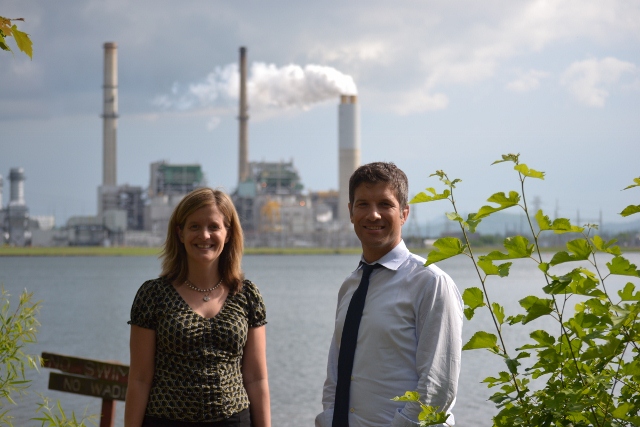
Bruce Nilles, director of Sierra Club’s Beyond Coal campaign (pictured here with local staffer Kelly Martin) spoke at the May 23 Asheville Green Drinks. His goal: Start a local conversation about retiring Progress Energy’s plant in Skyland and get WNC off coal for good. Photo courtesy of Jenna Garland.
There’s an ironic juxtaposition of the old and the new Asheville on display along Interstate 26 as you approach this town, says Bruce Nilles, Sierra Club’s Beyond Coal campaign director. There’s the Progress Energy plant, burning coal day and night to provide power to consumers across Western North Carolina; and just a short distance away next to Interstate 40 is the expansive new solar farm, recently installed on the Biltmore Estate.
Nilles is currently on tour, spreading the word about the environmental group’s decade-old fight against coal-fired power; he stopped in Asheville on May 23 for Green Drinks, Asheville’s enviro-social hour. The goal: Start a local conversation about retiring Progress Energy’s Skyland plant, and get WNC off coal for good.
In the last 10 years, Nilles reports, the Sierra Club initiative has helped keep 168 new coal-powered plants from coming online. This year, it’s moving to the next phase: Targeting existing plants for retirement. And among the priorities on their list for closure is Progress Energy’s power plant in Skyland.
He was welcomed by a standing-room only crowd in the back room of Green Drinks’ weekly host, Posana Café. He acknowledged this community’s decidedly green identity, remarking, “Asheville is iconic for several reasons. … But there is no way Asheville can be a leader in that arena, as long as it is tethered to a 19th-century coal plant that is putting out the equivalent of 200,000 cars’ worth of greenhouse gases each year. I mean, [this plant] is a monster.”
Pushing progress on Progress?
Nilles told the crowd at Posana that the U.S. needs to lead by example, the way Germany and Italy and other nations have done. “We emit more greenhouse gases than any other country,” he said. “Shutting down the remaining 522 coal plants [nationwide] is about getting us on a downward trajectory of greenhouse gas emissions.”
“We want to broaden the conversation,” Nilles continued. “The solution is not more-friendly coal mining. It’s not better-lined coal ash pits. It’s not better pollution controls. It’s a vision of no more coal. So how do we get there?”
The answer probably comes in part through the power of Sierra Club’s extensive grass-roots network. “One of the delights of working with the Sierra Club,” he said, “is wherever a coal plant is proposed, we always have a group whose backyard that is.”
Their success is evident across the U.S., Nilles argued. “As of a couple weeks ago, there are 168 coal plants stopped,” Nilles told the crowd. Twenty did get built, he pointed out, including the Cliffside plant in North Carolina.
“We hope Cliffside will go down as one of two of the last coal-fired plants built,” said Nilles. Another plant, Great River Energy’s Spiritwood Station in North Dakota was finished last year, cost $450 million to build, but isn’t running. “EPA’s new greenhouse gas standard for coal-fired power plants really is the end of conventional coal plants,” Nilles told the crowd, “and very likely the end of new coal altogether.”
But it appears the Beyond Coal campaign will not be deterred. “At the end of the day, they don’t get to shape our future alone,” Nilles said. “The community actually probably wants to have a say. Does Progress want to align itself with the community, or does it want to try to force [the old way] on the community … to require you to keep burning coal, along with the destructive mining practices in Appalachia?”
“That’s the conversation we want to have,” he said. “This is solvable. And Progress Energy will be part of the solution.”



Here’s a more detailed picture of the Asheville coal plant:
http://innovograph.blogspot.com/2012/05/asheville-area-coal-consumption.html
Asheville/WNC current state update.
Asheville area coal consumption and amplifying our energy strategic innovation ecosystem.
May 11, 2012.
Updated May 16, 2012.
by Grant Millin, InnovoGraph.